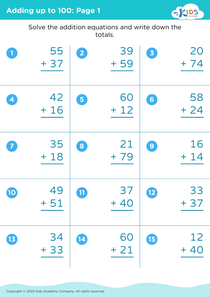Color Identification Adding up to 50 Worksheets for Ages 4-7
7 filtered results
-
From - To
Enhance your child's math and color recognition skills with our "Color Identification Adding up to 50 Worksheets" designed for ages 4-7. These engaging worksheets combine fun with learning, helping young learners practice addition skills up to 50 while simultaneously identifying and coloring objects based on provided instructions. Perfect for early grade levels, each worksheet introduces a creative way to solidify basic math concepts and improve fine motor skills, making learning enjoyable and effective. These printables are ideal for parents, teachers, and caregivers looking to support their children's educational journey in a dynamic and visually stimulating manner.
Color Identification and early math skills, such as adding up to 50, lay a strong foundation for a child's academic and cognitive development. For ages 4-7, these skills are particularly crucial as they encompass both visual recognition and mathematical understanding, elements central to multiple aspects of learning. When children identify colors, they sharpen their visual discrimination and vocabulary. This ability helps in other subjects, like reading and science, where distinguishing various elements is key.
Combining color identification with basic addition introduces a fun, integrative approach to learning. For example, if we ask children to count colored blocks and add them to find a total up to 50, they practice math in a tangible way. This hands-on activity makes abstract concepts more concrete and understandable.
Early exposure to these dual skills fosters better number sense, problem-solving abilities, and critical thinking. It also builds confidence and sets a positive attitude towards learning new skills. Moreover, parents and teachers engaging in these educational games with children forge stronger bonds while promoting an interactive learning environment. In an educational landscape that increasingly values STEAM (Science, Technology, Engineering, Arts, Mathematics) skills, starting with such foundational competencies equips children for future success.























